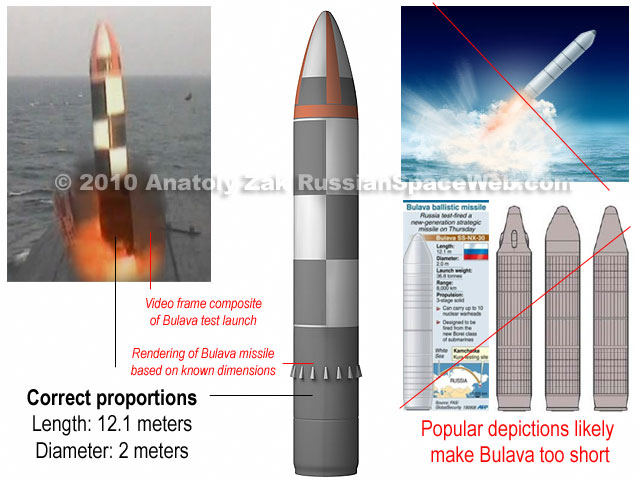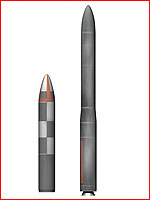E
EarthlingX
Guest
rt.com : Bulava missile: 13th time lucky (video)
http://www.russianspaceweb.com : Bulava (SS-NX-30) submarine based ballistic missile
Wiki : RSM-56 Bulava
...Published 07 October, 2010, 23:57
Edited 08 October, 2010, 11:02
The newest Russian intercontinental nuclear missile Bulava has successfully been tested on Thursday. All warheads hit their targets on Kamchatka Peninsula.
Strategic ballistic missile nuclear-powered submarine Dmitry Donskoy, the world’s biggest existing submarine, has successfully launched the Bulava missile from the White Sea in Russia’s Far North to the Kura Range, 380 kilometers to the north of Petropavlovsk-Kamchatsky city.
This launch breaks a chain of unsuccessful tests. Unofficially, of the previous 12, only five were considered fully effective.
Bulava (SS-NX-30 by NATO classification) is Russia’s latest three-stage, solid-propellant missile, which carries 10 hypersonic maneuvering warheads with a payload up to 150 kilotons each, at a distance of up to 8,000 kilometers.
The missile was designed specially for the new SSBN Borey class, which is set with the missile silos inclined towards the stem so they can be fired from submerged positions without stopping the vessel. Construction of the first Borey class submarine Yury Dolgoruky is complete. The construction of the other two, Aleksandr Nevsky and Vladimir Monomakh, is underway.
The first one will carry 10 missiles, while the following ones will have 12 silos.
The previous failures of the missile put the whole project under question at a certain point, but it was decided to drive a nail home. Thus the responsibility for the launch was immense and unprecedented measures of production quality control were introduced.
Borey submarines armed with Bulava missiles are expected to be an integral part of the Russian nuclear triad until 2040.
http://www.russianspaceweb.com : Bulava (SS-NX-30) submarine based ballistic missile
...
Above: Most depictions of Bulava in popular press do not match either reported dimensions of the missile or available footage of its test launches. Since Russian military made no secret as of the general appearance of the missile, these discrepancies are more likely the result of media incompetence, rather than a deliberate attempt at disinformation.
The submarine-based R-30 Bulava (Mace) was conceived to replace an ill-fated R-39 Bark missile, which featured a first stage built in Ukraine. In 1997, Moscow-based Teplotekhnik Institute, MIT, was assigned to develop Bulava. It would be the first submarine-based missile project for the design bureau, which previously specialized in ground-based mobile ICBMs such as Topol-M.

Likely relative size of the Bulava (left) and Topol-M ICBMs. Copyright © 2010 Anatoly Zak
...2010 Oct. 7: A long-anticipated 13th launch of the Bulava missile was successful, Russian Ministry of Defense announced. The rocket was launched from Dmitry Donskoy submarine stationed in the White Sea in the direction of the Kura impact range on the Kamchatka Peninsula. According to the Ministry of Defense spokesman, all warheads reached Kura. Two more test launches were promised during 2010, including one from Dmitry Donskoy and one from an operational version of the submarine - Yuri Dolgoruky.
Wiki : RSM-56 Bulava
...The Bulava (Russian: Булава, lit. "mace"; designation RSM-56, NATO reporting name SS-NX-32, GRAU index 3M30) is a submarine-launched ballistic missile under development for the Russian Navy and to be deployed on the new Borei class of ballistic missile nuclear submarines. It is intended as the future cornerstone of Russia's nuclear triad, and is the most expensive weapons project in the country.[4] The weapon takes its name from the Bulawa mace, a stylized headcrusher carried as a staff of office by a hetman, or supreme military commander, in medieval Eastern Europe.



